Comparing the Vanguard S&P 500 ETF (VOO 1.08%) to the Invesco QQQ Trust, Series 1 (QQQ 1.91%) means weighing two of the largest U.S. equity ETFs. VOO tracks the S&P 500, covering the 500 biggest U.S. companies, whereas QQQ focuses on the NASDAQ-100, emphasizing tech and growth. Here's how they stack up for cost, performance, risk, and portfolio makeup.
Snapshot (cost & size)
| Metric | QQQ | VOO |
|---|---|---|
| Issuer | Invesco | Vanguard |
| Expense ratio | 0.20% | 0.03% |
| 1-yr return (as of Oct. 27, 2025) | 26.8% | 18.0% |
| Dividend yield | 0.4% | 1.1% |
| Beta | 1.10 | 0.10 |
| AUM | $410.2 billion | $1.4 trillion |
Beta measures price volatility relative to the S&P 500; figures use five-year weekly returns.
VOO is considerably more affordable, with a 0.03% expense ratio versus QQQ's 0.20% (as reported by Financial Modeling Prep as of Oct. 28, 2025). It also offers a higher yield, paying 1.1% compared to QQQ's 0.4% (as of Oct. 27, 2025), which may appeal to income-focused investors.
Performance & risk comparison
| Metric | QQQ | VOO |
|---|---|---|
| Max drawdown (5 y) | -35.12% | -24.52% |
| Growth of $1,000 over 5 years | $2,312 | $2,100 |
What's inside
VOO tracks the S&P 500, offering exposure to 505 companies. Its largest positions are NVIDIA (NVDA 3.27%), Microsoft (MSFT 1.02%), and Apple (AAPL +0.04%), each accounting for around 0.07%–0.08% of the fund. With over 15 years on the market, VOO seeks to mirror the performance of the U.S. large-cap landscape, minimizing concentration risk.
In contrast, QQQ follows the NASDAQ-100, which results in a much heavier technology tilt (54%), with communication services and consumer cyclical stocks making up another 29%. Its top holdings, NVIDIA, Microsoft, and Apple are the same but they carry slightly more weight in QQQ than in VOO. QQQ's focus on 101 companies means less diversification and greater exposure to tech sector swings.
For more guidance on ETF investing, check out the full guide at this link.
Foolish take
The Invesco QQQ Trust, Series 1 ETF may be less diversified than the Vanguard 500 Index Fund ETF but this hasn't mattered to investors in recent years. Fear of missing out on the artificial intelligence revolution has been a tremendous tailwind for the tech stocks the Invesco QQQ Trust follows most closely.
Over the past three years, the Vanguard 500 Index Fund ETF delivered an 80.6% return or 88.6% if you included dividend payments. That's a terrific three-year return, but it pales in comparison to the Invesco QQQ Trust's performance. Over the same time frame, it delivered a 130.8% gain, or 135.3% if you add up dividend payments.
While the past few years have been terrific ones for the Invesco QQQ Trust, stocks in the index appear generally overpriced. The average stock in the Nasdaq 100 index has been trading for 33.25 times trailing 12-month earnings.
Glossary
ETF (Exchange-Traded Fund): An investment fund traded on stock exchanges, holding a basket of assets like stocks or bonds.
Expense ratio: The annual fee, as a percentage of assets, that a fund charges its shareholders.
Diversification: Spreading investments across various assets to reduce risk.
Dividend yield: Annual dividends paid by a fund or stock, expressed as a percentage of its price.
Beta: A measure of an investment's volatility compared to the overall market, typically the S&P 500.
AUM (Assets Under Management): The total market value of assets that a fund manages for investors.
Max drawdown: The largest observed percentage drop from a fund's peak value to its lowest point over a period.
Growth of $1,000 over 5 years: How much a $1,000 investment would be worth after five years, including gains.
Concentration risk: The risk of losses due to heavy investment in a small number of assets or sectors.
NASDAQ-100: An index of 100 of the largest non-financial companies listed on the NASDAQ stock exchange.
Large-cap: Refers to companies with a large market capitalization, typically over $10 billion.
Consumer cyclical: Companies whose sales and profits tend to rise and fall with the economic cycle, like retailers and automakers.






